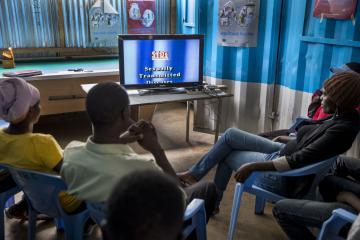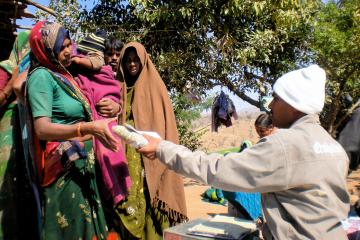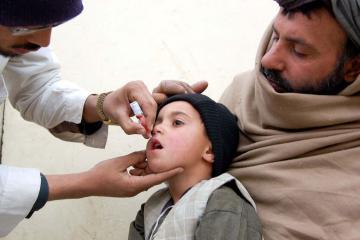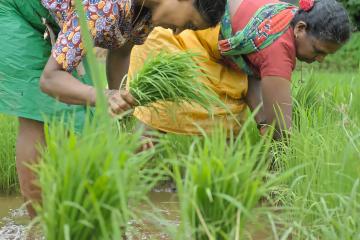
Making vaccines easier to access and more in-demand protects children from getting sick and dying from preventable diseases.

Making sure vaccines are reliably and locally available, and that health workers are incentivized to do their jobs well, can boost vaccine coverage in areas where access is limited.
Where vaccines are already available, programs that increase families’ demand for vaccines are highly effective and cost-effective in saving lives. Incentives, reminders, and information about the benefits of vaccines can make parents more likely to vaccinate their children. Governments and health care providers should incorporate these approaches to help bridge the vaccination gap.
Combined strategies lead to greater impact. Health departments and funders should consider bundling multiple approaches, like text reminders, incentives, and information from socially well-connected messengers, to increase vaccine access and reduce barriers for families.
Widespread immunization has transformed public health in recent decades. Vaccines are a highly effective and inexpensive way to save children’s lives; they have prevented an estimated 150 million deaths over the last fifty years. Yet despite this progress, 14.5 million children globally went without vaccinations in 2023, and over two million children die each year from vaccine-preventable diseases.
Boosting immunization coverage requires a tailored approach. There are many reasons why a child might miss life-saving vaccines—health systems might not be working for local communities, and families might be hesitant or might not have the means to get their children vaccinated.
If clinics are far away, bringing vaccines closer to families can boost coverage. Local, temporary (or mobile) immunization “camps” in rural villages can make it easier for families to access vaccines. In India, for example, a randomized evaluation found that immunization camps had a large impact on improving vaccine coverage, compared to relying on local public health clinics that were harder to access. The immunization camps were reliable and accompanied by vaccine education from a social worker, whereas public health clinics often had absent staff.
In places where vaccination rates are low and health workers are not doing their jobs, programs that improve workers’ job performance can boost coverage. In Pakistan, for example, community health workers administered more polio vaccines when their supervisors monitored their activities via smartphone, and the workers received cash for performing better. Results of randomized evaluations show that monitoring programs may be more effective in contexts where vaccine coverage is particularly low.
If vaccines are readily available but vaccination rates are still low, programs that help increase families’ demand for vaccines can boost coverage. Families may still have trouble vaccinating their children for a range of reasons, including not being able to afford travel to the clinic or medical fees, limited or inaccurate information about the benefits of vaccines, or procrastinating or forgetting appointments in the face of limited time and competing priorities. Providing incentives, text message reminders, and information about the benefits of vaccines can make parents more likely to vaccinate their children.
Bundling approaches that increase demand for vaccines can maximize their impact. For example, combining small mobile phone credit incentives for families, “nudge” text message reminders to caregivers, and information about the benefits of vaccines through community “ambassadors” helped boost immunization in India by more than 40 percent. The bundled approach was most effective in lower-income areas with low initial vaccine levels, where it increased the immunization rate six-fold (approximately 500 percent).

Cost and design considerations
Immunization is already a highly cost-effective way of improving child survival. Programs that increase families’ demand for vaccines can make it even more cost-effective. In India, researchers used machine learning to test 75 unique combinations of reminder SMS texts, mobile phone credit incentives, and local immunization ambassadors to spread information. The most cost-effective bundle combined text message reminders with community ambassadors and omitted incentives. This policy increased the number of immunizations per dollar by about 9 percent relative to those receiving standard services, and reduced the cost per immunization.
Providing incentives for parents alongside other interventions can improve cost-effectiveness. In an earlier example from India, giving families a small incentive—a package of lentils for each vaccine and a set of plates when kids finished the full immunization course—at an immunization camp not only increased immunization coverage, but also cut costs in half, from US$50 to US$25 per fully immunized child. Camps that gave incentives were also busier and used the nurses’ time more efficiently.
Programs to improve health workers’ job performance should be designed with local contexts in mind. In Uganda, for example, a community monitoring and information program improved vaccine coverage at a time when only 66 percent of children in Uganda were fully vaccinated, but a similar program implemented later had limited impact once full immunization coverage across the country had improved to 85 percent. This suggests monitoring programs may be more effective in areas where vaccine coverage is low. Similarly, incentivizing good job performance through pay-for-performance programs may be most impactful in health systems with high levels of transparency and accountability, and when accompanied by interventions to increase demand for health care services, like cash transfers and information campaigns.
Providing families with actionable information from socially influential community members is more effective than sharing general health information. Social networks can be useful tools to spread important information, like when and where vaccines are available and the presence of incentives, and can amplify the effects of other interventions. Spreading messages through local community "ambassadors" via phone or word-of-mouth can also increase demand by sharing the benefits of immunization or keeping vaccines salient for their communities. Still, information alone is sometimes not enough to shift behavior if families face other barriers like cost; in these cases, pairing information with incentives can help boost coverage.
Providing families with actionable information from socially influential community members is more effective than sharing general health information.
Implementing partners
Implementers bring deep local knowledge, technical expertise, and a commitment to evaluation and learning as they bring these programs to life. Many non-governmental organizations help implement evidence-informed immunization programs, including the following (listed in alphabetical order); this list is not exhaustive.
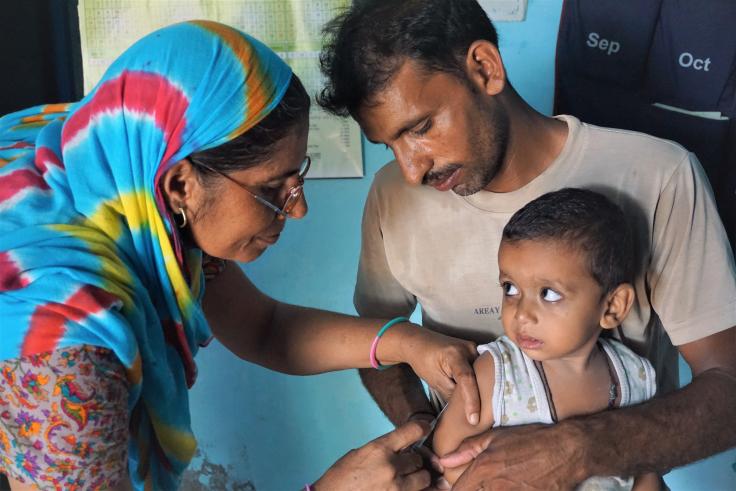
The role of foreign assistance and philanthropy
Philanthropic, bilateral, and multilateral donors have long played a critical role in testing and supporting innovative approaches to improving childhood immunization. Support from funders like the Global Innovation Fund, GiveWell, and USAID Development Innovation Ventures has enabled rigorous evaluations of immunization incentive programs in Pakistan and India. These investments helped generate actionable evidence, informed government policy, and expanded cost-effective immunization programs.
Funders and NGOs can catalyze innovation, but governments are best positioned to improve people’s lives at scale. While funders and NGO implementers often have an advantage in early-stage testing and learning, low- and middle-income country government leadership is central to large-scale implementation. And collaborations between these actors allow public agencies to commit resources to scale programs with a track record of effectiveness.
For example, in Pakistan, the Health Department of the Government of Sindh collaborated with the NGO IRD to scale up the evaluated immunization program. In India, J-PAL South Asia is collaborating with state governments and the NGO Suvita to develop pathways to scale the most cost-effective bundle of programs, with support from J-PAL’s Innovation in Government Initiative.
Public-private partnerships that mobilize a mix of donor and private sector industry contributions are also important for lowering the costs of vaccines and enabling broader implementation. J-PAL is collaborating with Gavi, the Vaccine Alliance, in sub-Saharan Africa to pilot and test immunization incentive programs.
Discover more from J-PAL
Discover more from other sources
Photos:
(1) A mother and her baby meeting with a health worker in Haryana, India. Credit: J-PAL
(2) A child receiving an immunization dose in Haryana, India. Credit: Shobhini Mukerji, J-PAL
